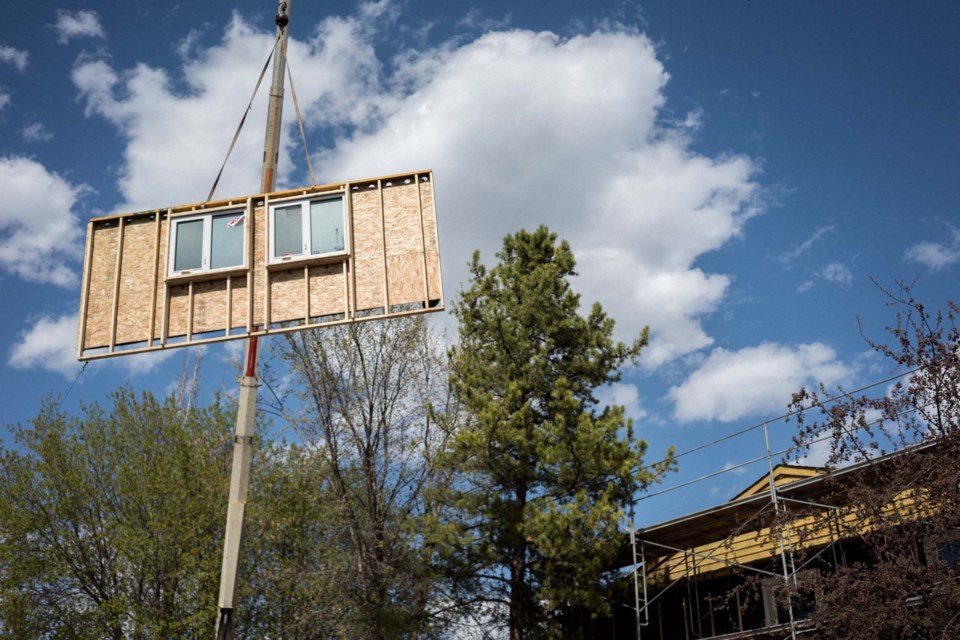The Carbon Challengers
Global heating is a major challenge to the way Albertans live, but it’s a challenge Albertans are rising to meet with new ideas for more sustainable, profitable lives. Once or twice a month, The Carbon Challengers will profile an Edmonton-area resident who has a cool idea to help keep the planet cool.
Do you know a carbon challenger? Email [email protected] with the details.
When it comes to building a green tomorrow, Peter Amerongen sticks pretty close to home.
He can see his first net-zero home – the Riverdale project – through the window by his drafting table in the basement of his Edmonton home. If he steps outside to look at it, he’ll see his current project right next door: the Sundance Housing Co-Op. He guessed that there were about another 30-odd other energy-efficient homes he’d designed in this neighbourhood alone.
“I’m lazy and I hate to drive,” he joked, when asked about this coincidence – he’s just jumped on opportunities to build green as they’ve come along.
Amerongen, 73, is considered by many to be the father of net-zero energy home design in the Edmonton region. His homes, which include the upcoming net-zero affordable housing complex in Morinville, typically produce as much energy as they consume during a year (resulting in zero net heat-trapping pollution) and serve as bulwarks against global heating.
Net-zero guru
Amerongen has pretty much had a home on the Eco-Solar Home Tour every year since 2008, said tour president Andrew Mills. He’s also pioneered and/or helped popularize energy-saving technologies in Edmonton such as passive solar heating, solar awnings and insulated basement slabs. Whenever he builds a new net-zero home, he also goes out of his way to explain how it all works.
“He keeps no secrets,” Mills said – he wants others to copy him and build more efficient homes.
Amerongen said he started building efficient homes in the 1970s when everyone was worried about oil running out. He got into net-zero homes in the 2000s when global heating became the big problem, and has more recently turned his eye to net-zero retrofits.
We have to slash our building-related carbon emissions to net-zero by 2050 if we are to keep global heating well below 2 C, Amerongen said, citing data from the non-profit Architecture 2030. Buildings account for about 40 per cent of the world’s heat-trapping pollution, and 70 to 80 per cent of the buildings we’re going to be using in 2050 have already been built. That means there are billions of dollars of homes in Alberta alone that need some serious energy efficiency upgrades in the next 30 years.
“There’s no way you’re going to get that drop in (emissions) if you don’t retrofit on an industrial scale,” he said.
“Our sustainable future depends on it.”
Faster and cheaper
Deep or comprehensive energy retrofits are rare in Edmonton, said Stuart Fix of ReNü Engineering Inc., a coworker of Amerongen’s – he knows of perhaps a dozen, and one of them is his own home. Retrofits tend to be arduous, one-off affairs where you have to rip open walls and temporarily evict whoever’s in the place so you can renovate.
A few years ago, Amerongen said some NAIT students asked to partner with him on a home energy retrofit project. One of them had heard of a new Dutch process called Energiesprong that promised to make retrofits faster and cheaper.
Energiesprong sees designers take laser scans of a home to quickly create super-insulated panels complete with windows, tiles, and siding that can fit precisely over existing roof and walls, Amerongen and Fix explained. Those panels are ideally made in a factory off-site to reduce costs. Instead of ripping down the old walls and roof, crews simply bolt the new panels overtop, allowing them to renovate the home’s outside without affecting the people inside. Teams in the Netherlands have retrofitted some 5,000 townhouses this way, needing as little as three weeks per home.
Amerongen partnered with Fix, Butterwick Construction and Natural Resources Canada to test this technique at the Sundance Housing Co-op last year. They took two of the co-op’s units – one of which was the birthplace of Amerongen’s son – scanned them, built new walls and a roof, and hoisted and bolted them into place, turning the 1970s-era homes into a net-zero-ready (i.e. net zero with solar panels) site in just three months for $120,000 per unit. The team is now gearing up to do the other 57 units in the co-op. If they can master the Energiesprong technique, they think they could do one unit a month for $85,000.
Fix said deep-energy retrofits like this one make the most sense if you already have to replace your siding and roof tiles (as was the case here) and you’re concerned about your home’s operating costs. He estimates that the co-op should recoup its investment in these retrofits in 25 years – sooner if energy prices go up.
Energiesprong has proved challenging, as this was one of the first times anyone’s tried doing it in Canada, Amerongen said – he’s already got a list of about 240 lessons learned from last year’s test run. The team also still has to develop the capacity to mass-produce the panels for these retrofits.
Still, Amerongen saw potential with Energiesprong. Initiatives like PACE financing (which have homeowners pay the cost of retrofits through property tax over time) could help more people afford the up-front cost of these retrofits.
“There are 14 million homes in Canada and only a tiny fraction of them don’t need something like this,” Amerongen said.
“We think we could be on the ground floor of a multi billion-dollar business.”




